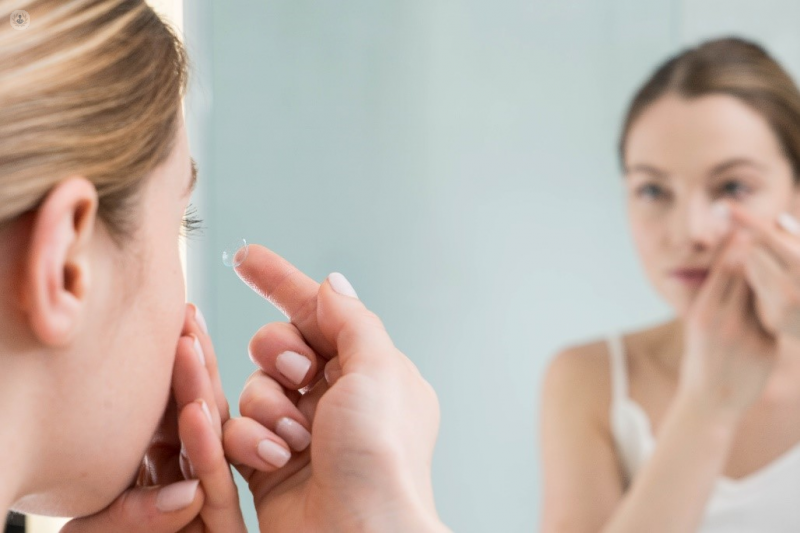reduce dry eyes contact lenses
Escrito por:Developing dry eyes symptoms from regular contact lens wear is an irritating, albeit common problem. While some patients already have an underlying dry eye disease, others wear contact lenses and then develop contact lens associated dry eye disease.
Professor Parwez Hossain, a leading ophthalmologist, is an expert in treating patients with dry eyes. He gives us his advice on how contact lens wearers can avoid this common problem.

Why can contact lenses cause dry eyes?
In a normal eye, we have a moist surface that is wetted by the tear film and associated components, particularly the lipid layer of the tear film. With contact lenses, the tear film has to coat both the surface of the eye and the contact lenses. With the older types of rigid lenses, very little oxygen can get through the lens, so over the years, contact lens manufacturers have modified the materials to improve this.
They began using hydrogel lenses which allows more water to be contained within the lens and, therefore, allows more oxygen to permeate through onto the surface of the eye. Generally speaking, the better the oxygen transmissibility, the better the level of comfort in the eye. However, by increasing the water content of the lens, the lens becomes much thicker. This becomes more challenging for patients with dry eyes as the high-water content can actually draw water from an already dry eye. Many manufacturers have now modified the intrinsic materials to improve comfort for people with dry eyes.
What materials are now used?
Over the last decade, lens manufacturers have developed a newer material: silicone hydrogel polymers.
This new material allows even higher levels of oxygen transmissibility. This soft contact lens allows them to be much thinner than normal, and as there’s less water being contained in the lens, it reduces the effects of hypoxia (deprivation of oxygen) making it more suitable for patients with dry eyes.
Which contact lenses are best for dry eyes?
Most of the newer lenses are made of silicone hydrogel. As mentioned, various manufacturers have modified the materials within the silicone hydrogel lenses to allow other components to improve the wettability of the contact lenses. Therefore, the tear film can go over both the top and bottom surfaces of the lens. The lenses are also generally much thinner and better tolerated by patients.
These lenses tend to come in different wearing modalities: They can be left in on a daily, weekly or monthly wear basis. Many of these lenses can also be combined with artificial tears.
All brands have their own respective designs and features, so a patient with an underlying dry eye disease should discuss their particular lenses with the relevant contact lens practitioner or optometrist.
My own preference is within the Acuvue range. This company is constantly innovating its products. They also have a variety of lenses that can be available on a daily or monthly wear basis and can also incorporate and improve the wettability of lenses and level of comfort.
Can you reduce dry eye symptoms caused by contact lenses?
There is a specific condition known as contact lens associated dry eye (CLADE) which can happen in regular contact lens wearers. You can reduce the level of symptoms by instilling lubricating eye drops that contain sodium hyaluronate. The typical concentration is 0.1%. Strong concentrations can lead to increased blurriness but some combination agents do not appear to cause this issue.
There is also a general view that contact lenses and dry eyes are not terribly compatible and only exacerbate the condition. Some ophthalmologists would recommend not wearing contact lenses at all. However, my own view is to take a pragmatic approach: I generally recommend that dry eye disease patients should go over to daily disposable contact lenses and/or use silicone hydrogel or hydrogel lenses with some of the latest technology available to improve the comfort levels.
What do you recommend for patients with dry eyes?
Firstly, the patient should consult their contact lens practitioner and trial with different lenses. They can also try to reduce their wear time (perhaps four to six hours per day) and also invest in a substitute pair of glasses for the times they don’t need to wear their contact lenses.
At the moment, we are experiencing a rapid change in the technology used to improve spectacles for reading, so it’s not unusual for patients to have both the latest form of contact lenses fitted as well as the latest form of glasses.
If you have dry eye syndrome, what sort of contact lens use do you recommend?
I have experience with the Johnson and Johnson’s Acuvue range which now comes with all varieties of wear patterns, particularly daily disposable ones that come in all sorts of fitting patterns. This brand also offers interesting opportunities and allows patients to extend their compatibility with their contact lenses, especially when their dry eye disease is becoming overwhelming.
Other contact lens companies are doing tremendously good work in developing new products and patients should see their optometrist or contact lens practitioner for their advice.
COVID-19: important advice for those who wear contact lenses
Some patients are concerned about the current outbreak of COVID-19 and spreading the virus via their contact lenses. It is extremely important to maintain both excellent personal hygiene and contact lens hygiene. Before putting in and removing your contact lenses, you should wash your hands thoroughly to prevent the spread of COVID-19. For the time being, you may even want to consider using disposable contact lenses to reduce your risk of spreading or contracting the virus.
If you are experiencing symptoms of dry eyes and would like to see a specialist about this, book an appointment with Professor Parwez Hossain and visit him at his clinic.


